Business Model & Strategy Analysis
VerifiedAdded on 2020/01/07
|17
|4474
|685
Essay
AI Summary
This assignment delves into the concepts of business models and strategic management, analyzing their application within the automotive industry using Volkswagen as a case study. Students are tasked with examining various aspects of Volkswagen's business model, including its value proposition, target market, revenue streams, key activities, and partnerships. The assignment also requires an evaluation of competitive strategies employed by Volkswagen and an analysis of how operational efficiency contributes to its success.
Contribute Materials
Your contribution can guide someone’s learning journey. Share your
documents today.
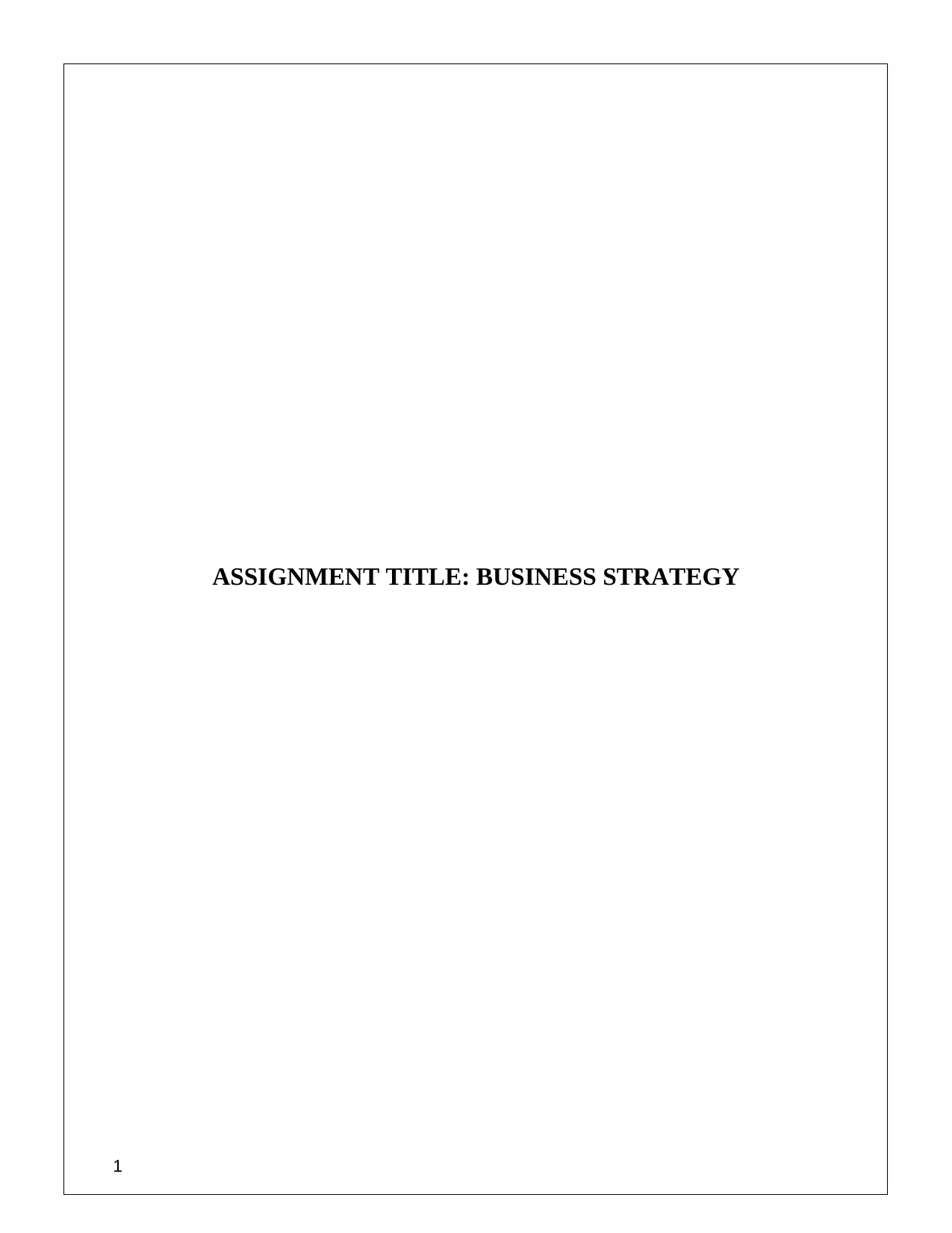
ASSIGNMENT TITLE: BUSINESS STRATEGY
1
1
Secure Best Marks with AI Grader
Need help grading? Try our AI Grader for instant feedback on your assignments.
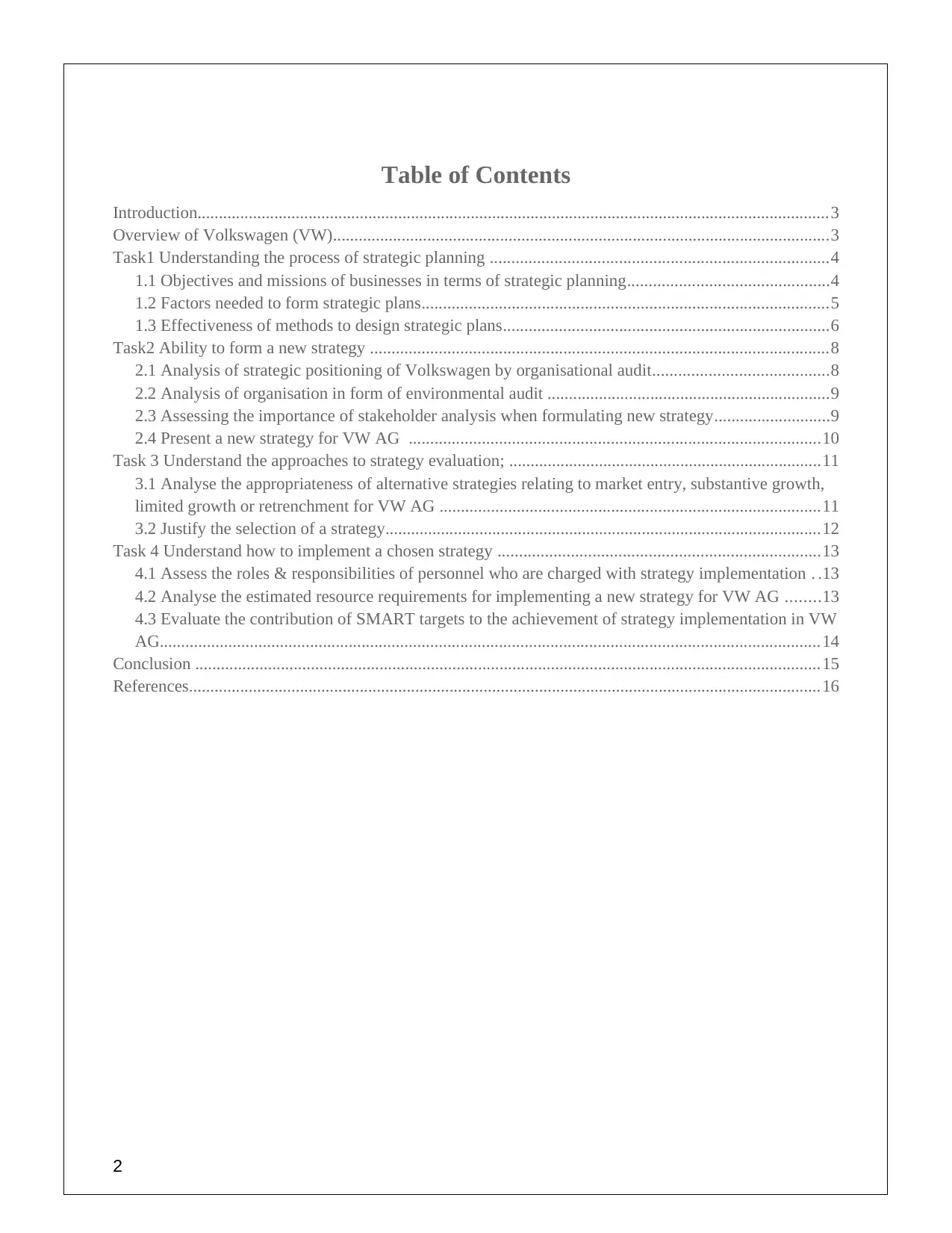
Table of Contents
Introduction....................................................................................................................................................3
Overview of Volkswagen (VW)....................................................................................................................3
Task1 Understanding the process of strategic planning ...............................................................................4
1.1 Objectives and missions of businesses in terms of strategic planning...............................................4
1.2 Factors needed to form strategic plans...............................................................................................5
1.3 Effectiveness of methods to design strategic plans............................................................................6
Task2 Ability to form a new strategy ...........................................................................................................8
2.1 Analysis of strategic positioning of Volkswagen by organisational audit.........................................8
2.2 Analysis of organisation in form of environmental audit ..................................................................9
2.3 Assessing the importance of stakeholder analysis when formulating new strategy...........................9
2.4 Present a new strategy for VW AG ................................................................................................10
Task 3 Understand the approaches to strategy evaluation; .........................................................................11
3.1 Analyse the appropriateness of alternative strategies relating to market entry, substantive growth,
limited growth or retrenchment for VW AG .........................................................................................11
3.2 Justify the selection of a strategy......................................................................................................12
Task 4 Understand how to implement a chosen strategy ...........................................................................13
4.1 Assess the roles & responsibilities of personnel who are charged with strategy implementation . .13
4.2 Analyse the estimated resource requirements for implementing a new strategy for VW AG ........13
4.3 Evaluate the contribution of SMART targets to the achievement of strategy implementation in VW
AG..........................................................................................................................................................14
Conclusion ..................................................................................................................................................15
References....................................................................................................................................................16
2
Introduction....................................................................................................................................................3
Overview of Volkswagen (VW)....................................................................................................................3
Task1 Understanding the process of strategic planning ...............................................................................4
1.1 Objectives and missions of businesses in terms of strategic planning...............................................4
1.2 Factors needed to form strategic plans...............................................................................................5
1.3 Effectiveness of methods to design strategic plans............................................................................6
Task2 Ability to form a new strategy ...........................................................................................................8
2.1 Analysis of strategic positioning of Volkswagen by organisational audit.........................................8
2.2 Analysis of organisation in form of environmental audit ..................................................................9
2.3 Assessing the importance of stakeholder analysis when formulating new strategy...........................9
2.4 Present a new strategy for VW AG ................................................................................................10
Task 3 Understand the approaches to strategy evaluation; .........................................................................11
3.1 Analyse the appropriateness of alternative strategies relating to market entry, substantive growth,
limited growth or retrenchment for VW AG .........................................................................................11
3.2 Justify the selection of a strategy......................................................................................................12
Task 4 Understand how to implement a chosen strategy ...........................................................................13
4.1 Assess the roles & responsibilities of personnel who are charged with strategy implementation . .13
4.2 Analyse the estimated resource requirements for implementing a new strategy for VW AG ........13
4.3 Evaluate the contribution of SMART targets to the achievement of strategy implementation in VW
AG..........................................................................................................................................................14
Conclusion ..................................................................................................................................................15
References....................................................................................................................................................16
2
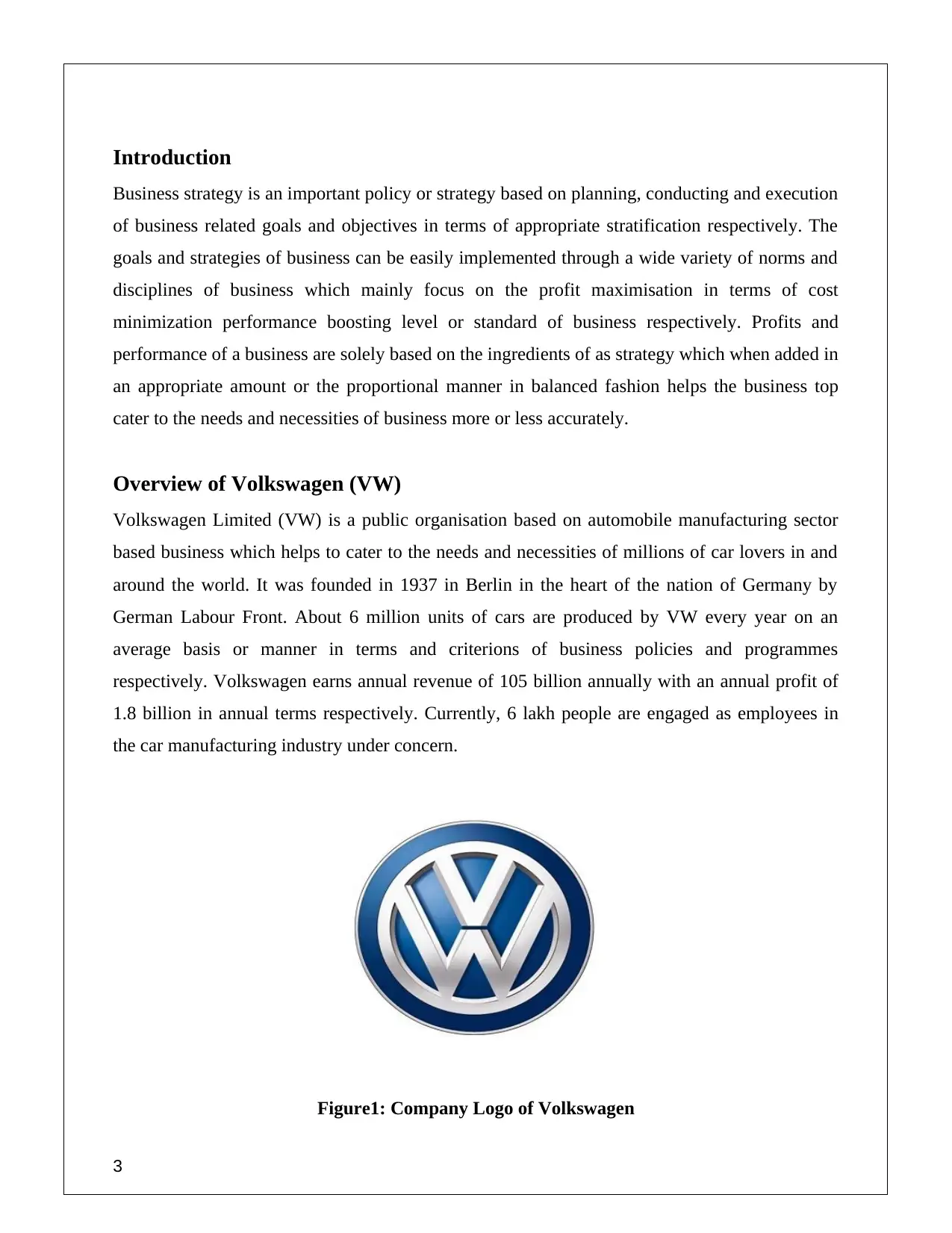
Introduction
Business strategy is an important policy or strategy based on planning, conducting and execution
of business related goals and objectives in terms of appropriate stratification respectively. The
goals and strategies of business can be easily implemented through a wide variety of norms and
disciplines of business which mainly focus on the profit maximisation in terms of cost
minimization performance boosting level or standard of business respectively. Profits and
performance of a business are solely based on the ingredients of as strategy which when added in
an appropriate amount or the proportional manner in balanced fashion helps the business top
cater to the needs and necessities of business more or less accurately.
Overview of Volkswagen (VW)
Volkswagen Limited (VW) is a public organisation based on automobile manufacturing sector
based business which helps to cater to the needs and necessities of millions of car lovers in and
around the world. It was founded in 1937 in Berlin in the heart of the nation of Germany by
German Labour Front. About 6 million units of cars are produced by VW every year on an
average basis or manner in terms and criterions of business policies and programmes
respectively. Volkswagen earns annual revenue of 105 billion annually with an annual profit of
1.8 billion in annual terms respectively. Currently, 6 lakh people are engaged as employees in
the car manufacturing industry under concern.
Figure1: Company Logo of Volkswagen
3
Business strategy is an important policy or strategy based on planning, conducting and execution
of business related goals and objectives in terms of appropriate stratification respectively. The
goals and strategies of business can be easily implemented through a wide variety of norms and
disciplines of business which mainly focus on the profit maximisation in terms of cost
minimization performance boosting level or standard of business respectively. Profits and
performance of a business are solely based on the ingredients of as strategy which when added in
an appropriate amount or the proportional manner in balanced fashion helps the business top
cater to the needs and necessities of business more or less accurately.
Overview of Volkswagen (VW)
Volkswagen Limited (VW) is a public organisation based on automobile manufacturing sector
based business which helps to cater to the needs and necessities of millions of car lovers in and
around the world. It was founded in 1937 in Berlin in the heart of the nation of Germany by
German Labour Front. About 6 million units of cars are produced by VW every year on an
average basis or manner in terms and criterions of business policies and programmes
respectively. Volkswagen earns annual revenue of 105 billion annually with an annual profit of
1.8 billion in annual terms respectively. Currently, 6 lakh people are engaged as employees in
the car manufacturing industry under concern.
Figure1: Company Logo of Volkswagen
3
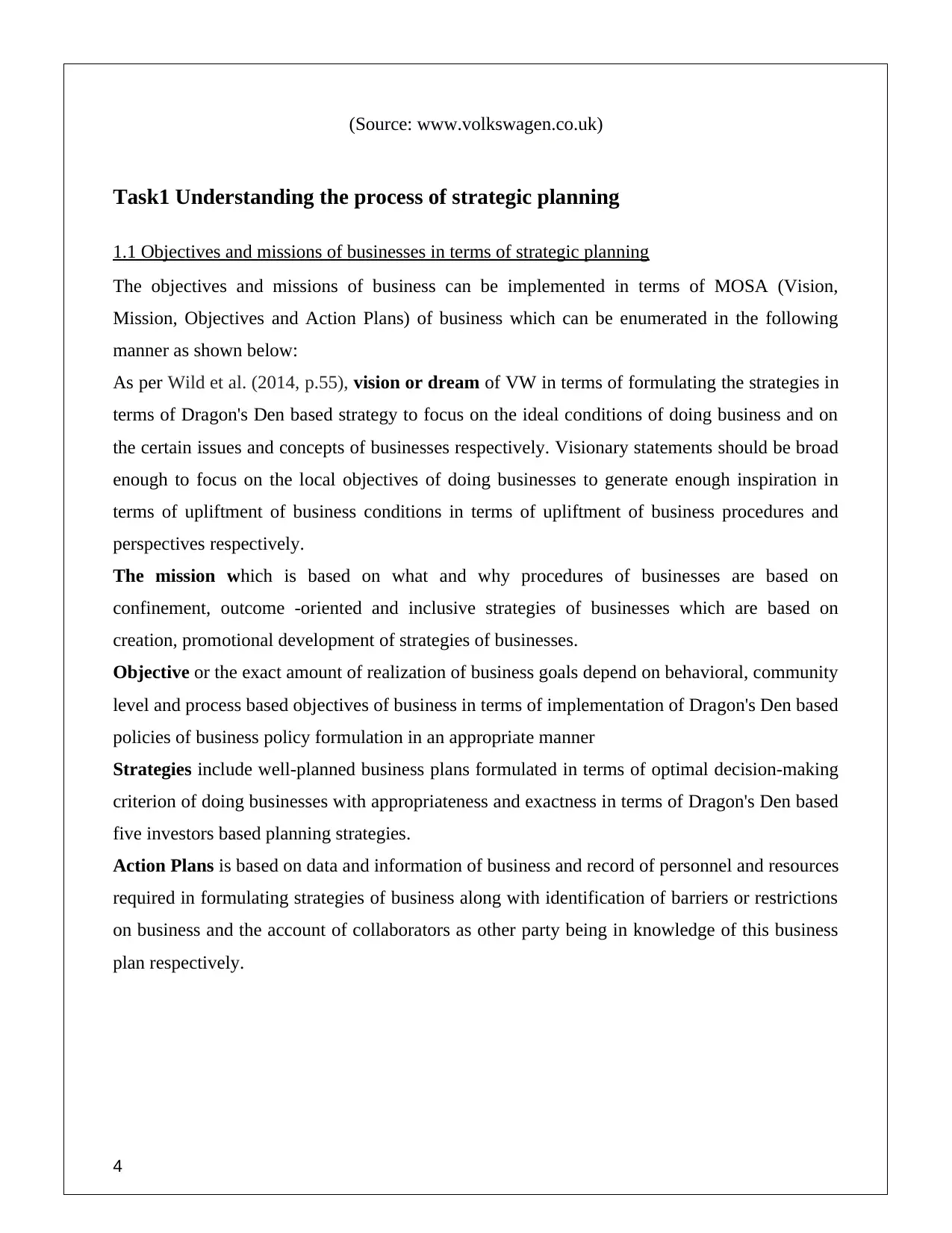
(Source: www.volkswagen.co.uk)
Task1 Understanding the process of strategic planning
1.1 Objectives and missions of businesses in terms of strategic planning
The objectives and missions of business can be implemented in terms of MOSA (Vision,
Mission, Objectives and Action Plans) of business which can be enumerated in the following
manner as shown below:
As per Wild et al. (2014, p.55), vision or dream of VW in terms of formulating the strategies in
terms of Dragon's Den based strategy to focus on the ideal conditions of doing business and on
the certain issues and concepts of businesses respectively. Visionary statements should be broad
enough to focus on the local objectives of doing businesses to generate enough inspiration in
terms of upliftment of business conditions in terms of upliftment of business procedures and
perspectives respectively.
The mission which is based on what and why procedures of businesses are based on
confinement, outcome -oriented and inclusive strategies of businesses which are based on
creation, promotional development of strategies of businesses.
Objective or the exact amount of realization of business goals depend on behavioral, community
level and process based objectives of business in terms of implementation of Dragon's Den based
policies of business policy formulation in an appropriate manner
Strategies include well-planned business plans formulated in terms of optimal decision-making
criterion of doing businesses with appropriateness and exactness in terms of Dragon's Den based
five investors based planning strategies.
Action Plans is based on data and information of business and record of personnel and resources
required in formulating strategies of business along with identification of barriers or restrictions
on business and the account of collaborators as other party being in knowledge of this business
plan respectively.
4
Task1 Understanding the process of strategic planning
1.1 Objectives and missions of businesses in terms of strategic planning
The objectives and missions of business can be implemented in terms of MOSA (Vision,
Mission, Objectives and Action Plans) of business which can be enumerated in the following
manner as shown below:
As per Wild et al. (2014, p.55), vision or dream of VW in terms of formulating the strategies in
terms of Dragon's Den based strategy to focus on the ideal conditions of doing business and on
the certain issues and concepts of businesses respectively. Visionary statements should be broad
enough to focus on the local objectives of doing businesses to generate enough inspiration in
terms of upliftment of business conditions in terms of upliftment of business procedures and
perspectives respectively.
The mission which is based on what and why procedures of businesses are based on
confinement, outcome -oriented and inclusive strategies of businesses which are based on
creation, promotional development of strategies of businesses.
Objective or the exact amount of realization of business goals depend on behavioral, community
level and process based objectives of business in terms of implementation of Dragon's Den based
policies of business policy formulation in an appropriate manner
Strategies include well-planned business plans formulated in terms of optimal decision-making
criterion of doing businesses with appropriateness and exactness in terms of Dragon's Den based
five investors based planning strategies.
Action Plans is based on data and information of business and record of personnel and resources
required in formulating strategies of business along with identification of barriers or restrictions
on business and the account of collaborators as other party being in knowledge of this business
plan respectively.
4
Secure Best Marks with AI Grader
Need help grading? Try our AI Grader for instant feedback on your assignments.
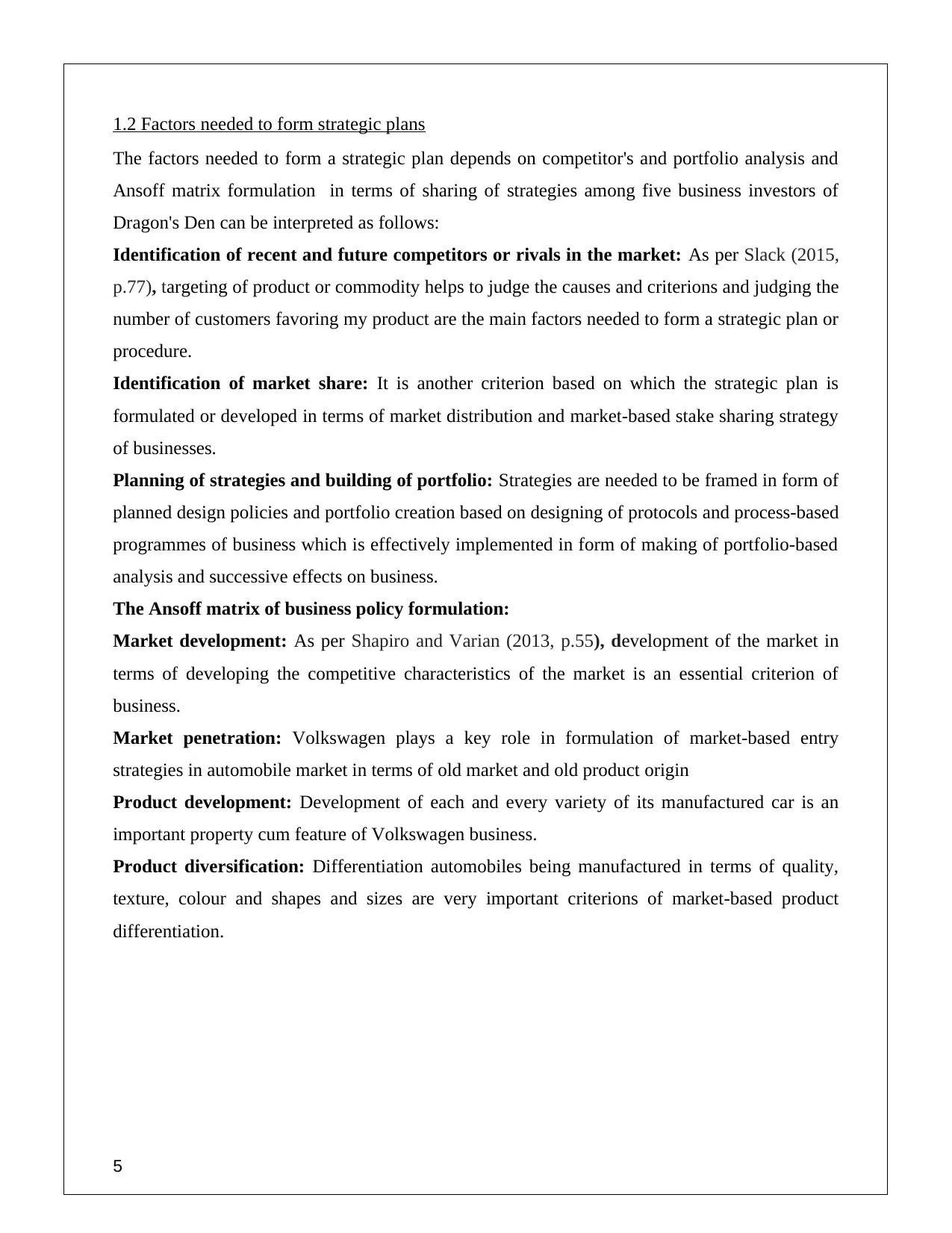
1.2 Factors needed to form strategic plans
The factors needed to form a strategic plan depends on competitor's and portfolio analysis and
Ansoff matrix formulation in terms of sharing of strategies among five business investors of
Dragon's Den can be interpreted as follows:
Identification of recent and future competitors or rivals in the market: As per Slack (2015,
p.77), targeting of product or commodity helps to judge the causes and criterions and judging the
number of customers favoring my product are the main factors needed to form a strategic plan or
procedure.
Identification of market share: It is another criterion based on which the strategic plan is
formulated or developed in terms of market distribution and market-based stake sharing strategy
of businesses.
Planning of strategies and building of portfolio: Strategies are needed to be framed in form of
planned design policies and portfolio creation based on designing of protocols and process-based
programmes of business which is effectively implemented in form of making of portfolio-based
analysis and successive effects on business.
The Ansoff matrix of business policy formulation:
Market development: As per Shapiro and Varian (2013, p.55), development of the market in
terms of developing the competitive characteristics of the market is an essential criterion of
business.
Market penetration: Volkswagen plays a key role in formulation of market-based entry
strategies in automobile market in terms of old market and old product origin
Product development: Development of each and every variety of its manufactured car is an
important property cum feature of Volkswagen business.
Product diversification: Differentiation automobiles being manufactured in terms of quality,
texture, colour and shapes and sizes are very important criterions of market-based product
differentiation.
5
The factors needed to form a strategic plan depends on competitor's and portfolio analysis and
Ansoff matrix formulation in terms of sharing of strategies among five business investors of
Dragon's Den can be interpreted as follows:
Identification of recent and future competitors or rivals in the market: As per Slack (2015,
p.77), targeting of product or commodity helps to judge the causes and criterions and judging the
number of customers favoring my product are the main factors needed to form a strategic plan or
procedure.
Identification of market share: It is another criterion based on which the strategic plan is
formulated or developed in terms of market distribution and market-based stake sharing strategy
of businesses.
Planning of strategies and building of portfolio: Strategies are needed to be framed in form of
planned design policies and portfolio creation based on designing of protocols and process-based
programmes of business which is effectively implemented in form of making of portfolio-based
analysis and successive effects on business.
The Ansoff matrix of business policy formulation:
Market development: As per Shapiro and Varian (2013, p.55), development of the market in
terms of developing the competitive characteristics of the market is an essential criterion of
business.
Market penetration: Volkswagen plays a key role in formulation of market-based entry
strategies in automobile market in terms of old market and old product origin
Product development: Development of each and every variety of its manufactured car is an
important property cum feature of Volkswagen business.
Product diversification: Differentiation automobiles being manufactured in terms of quality,
texture, colour and shapes and sizes are very important criterions of market-based product
differentiation.
5
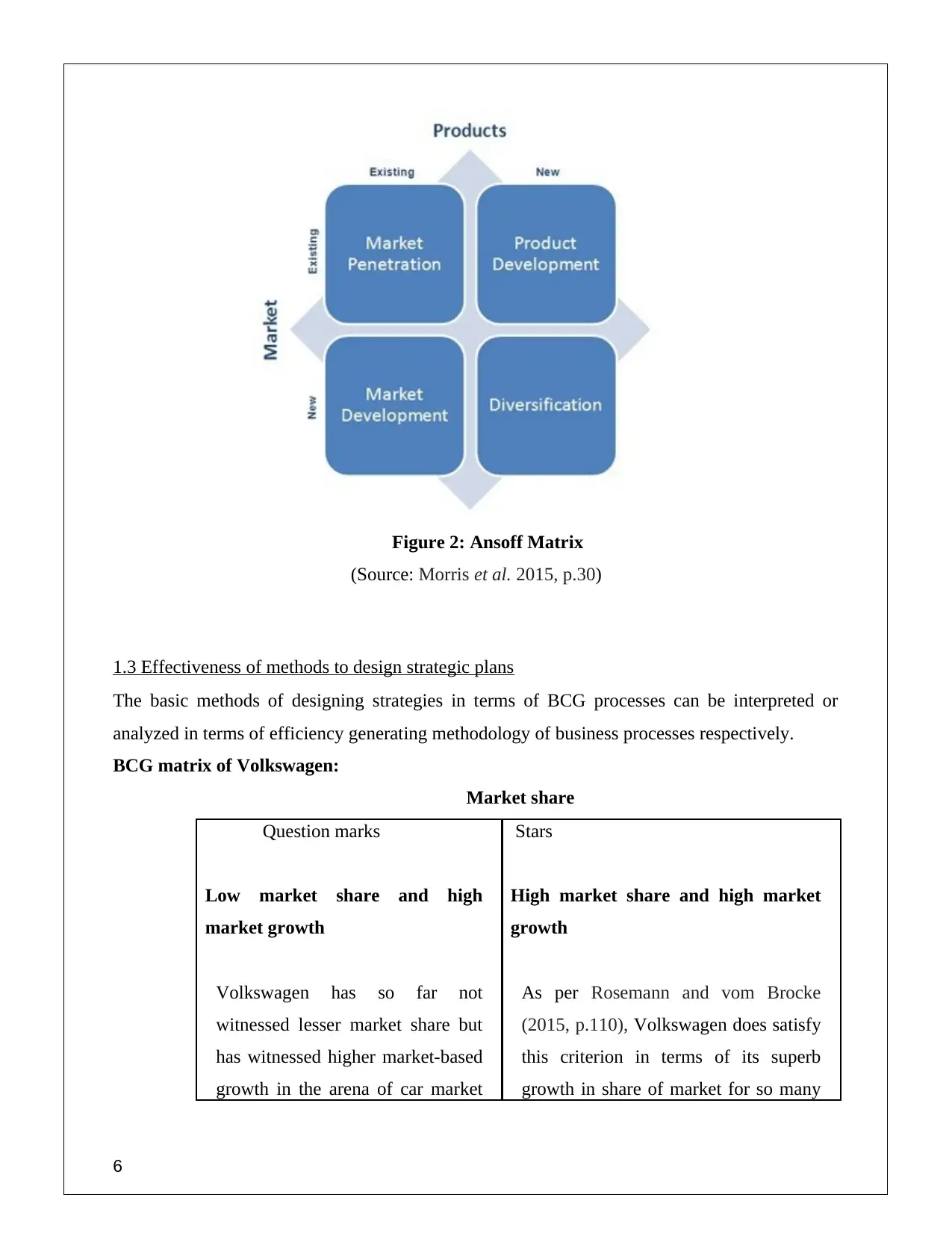
Figure 2: Ansoff Matrix
(Source: Morris et al. 2015, p.30)
1.3 Effectiveness of methods to design strategic plans
The basic methods of designing strategies in terms of BCG processes can be interpreted or
analyzed in terms of efficiency generating methodology of business processes respectively.
BCG matrix of Volkswagen:
Market share
Question marks
Low market share and high
market growth
Volkswagen has so far not
witnessed lesser market share but
has witnessed higher market-based
growth in the arena of car market
Stars
High market share and high market
growth
As per Rosemann and vom Brocke
(2015, p.110), Volkswagen does satisfy
this criterion in terms of its superb
growth in share of market for so many
6
(Source: Morris et al. 2015, p.30)
1.3 Effectiveness of methods to design strategic plans
The basic methods of designing strategies in terms of BCG processes can be interpreted or
analyzed in terms of efficiency generating methodology of business processes respectively.
BCG matrix of Volkswagen:
Market share
Question marks
Low market share and high
market growth
Volkswagen has so far not
witnessed lesser market share but
has witnessed higher market-based
growth in the arena of car market
Stars
High market share and high market
growth
As per Rosemann and vom Brocke
(2015, p.110), Volkswagen does satisfy
this criterion in terms of its superb
growth in share of market for so many
6
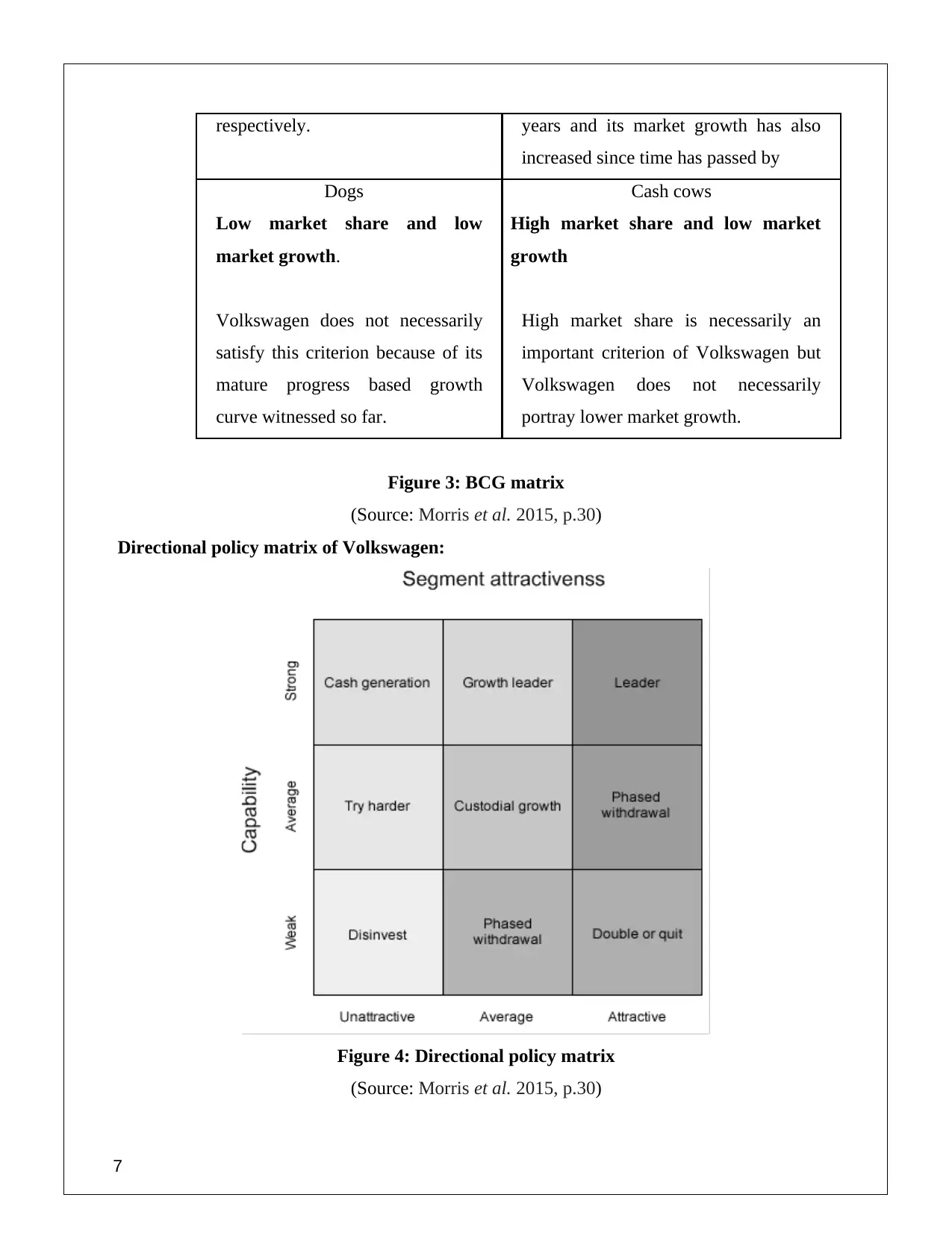
respectively. years and its market growth has also
increased since time has passed by
Dogs
Low market share and low
market growth.
Volkswagen does not necessarily
satisfy this criterion because of its
mature progress based growth
curve witnessed so far.
Cash cows
High market share and low market
growth
High market share is necessarily an
important criterion of Volkswagen but
Volkswagen does not necessarily
portray lower market growth.
Figure 3: BCG matrix
(Source: Morris et al. 2015, p.30)
Directional policy matrix of Volkswagen:
Figure 4: Directional policy matrix
(Source: Morris et al. 2015, p.30)
7
increased since time has passed by
Dogs
Low market share and low
market growth.
Volkswagen does not necessarily
satisfy this criterion because of its
mature progress based growth
curve witnessed so far.
Cash cows
High market share and low market
growth
High market share is necessarily an
important criterion of Volkswagen but
Volkswagen does not necessarily
portray lower market growth.
Figure 3: BCG matrix
(Source: Morris et al. 2015, p.30)
Directional policy matrix of Volkswagen:
Figure 4: Directional policy matrix
(Source: Morris et al. 2015, p.30)
7
Paraphrase This Document
Need a fresh take? Get an instant paraphrase of this document with our AI Paraphraser
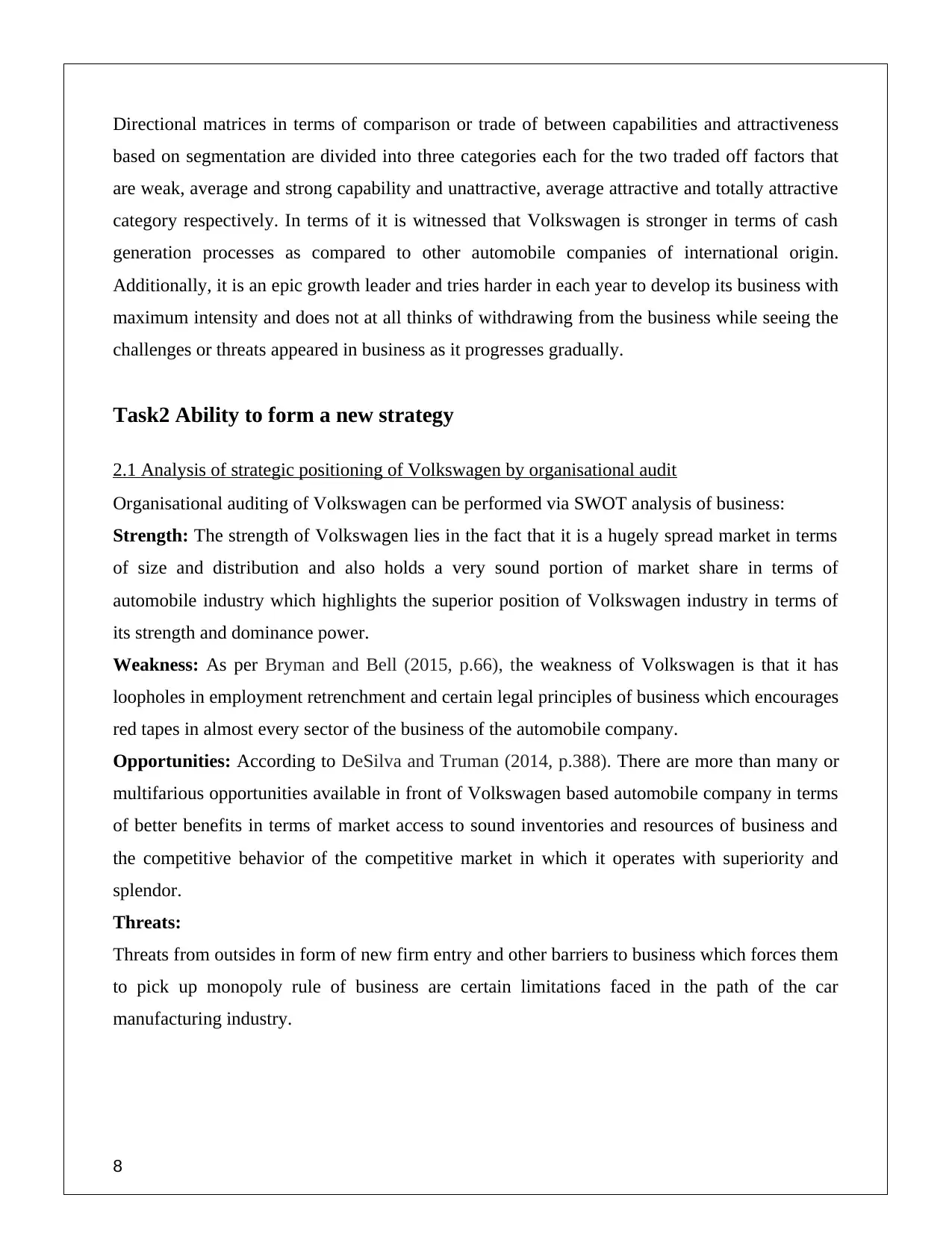
Directional matrices in terms of comparison or trade of between capabilities and attractiveness
based on segmentation are divided into three categories each for the two traded off factors that
are weak, average and strong capability and unattractive, average attractive and totally attractive
category respectively. In terms of it is witnessed that Volkswagen is stronger in terms of cash
generation processes as compared to other automobile companies of international origin.
Additionally, it is an epic growth leader and tries harder in each year to develop its business with
maximum intensity and does not at all thinks of withdrawing from the business while seeing the
challenges or threats appeared in business as it progresses gradually.
Task2 Ability to form a new strategy
2.1 Analysis of strategic positioning of Volkswagen by organisational audit
Organisational auditing of Volkswagen can be performed via SWOT analysis of business:
Strength: The strength of Volkswagen lies in the fact that it is a hugely spread market in terms
of size and distribution and also holds a very sound portion of market share in terms of
automobile industry which highlights the superior position of Volkswagen industry in terms of
its strength and dominance power.
Weakness: As per Bryman and Bell (2015, p.66), the weakness of Volkswagen is that it has
loopholes in employment retrenchment and certain legal principles of business which encourages
red tapes in almost every sector of the business of the automobile company.
Opportunities: According to DeSilva and Truman (2014, p.388). There are more than many or
multifarious opportunities available in front of Volkswagen based automobile company in terms
of better benefits in terms of market access to sound inventories and resources of business and
the competitive behavior of the competitive market in which it operates with superiority and
splendor.
Threats:
Threats from outsides in form of new firm entry and other barriers to business which forces them
to pick up monopoly rule of business are certain limitations faced in the path of the car
manufacturing industry.
8
based on segmentation are divided into three categories each for the two traded off factors that
are weak, average and strong capability and unattractive, average attractive and totally attractive
category respectively. In terms of it is witnessed that Volkswagen is stronger in terms of cash
generation processes as compared to other automobile companies of international origin.
Additionally, it is an epic growth leader and tries harder in each year to develop its business with
maximum intensity and does not at all thinks of withdrawing from the business while seeing the
challenges or threats appeared in business as it progresses gradually.
Task2 Ability to form a new strategy
2.1 Analysis of strategic positioning of Volkswagen by organisational audit
Organisational auditing of Volkswagen can be performed via SWOT analysis of business:
Strength: The strength of Volkswagen lies in the fact that it is a hugely spread market in terms
of size and distribution and also holds a very sound portion of market share in terms of
automobile industry which highlights the superior position of Volkswagen industry in terms of
its strength and dominance power.
Weakness: As per Bryman and Bell (2015, p.66), the weakness of Volkswagen is that it has
loopholes in employment retrenchment and certain legal principles of business which encourages
red tapes in almost every sector of the business of the automobile company.
Opportunities: According to DeSilva and Truman (2014, p.388). There are more than many or
multifarious opportunities available in front of Volkswagen based automobile company in terms
of better benefits in terms of market access to sound inventories and resources of business and
the competitive behavior of the competitive market in which it operates with superiority and
splendor.
Threats:
Threats from outsides in form of new firm entry and other barriers to business which forces them
to pick up monopoly rule of business are certain limitations faced in the path of the car
manufacturing industry.
8
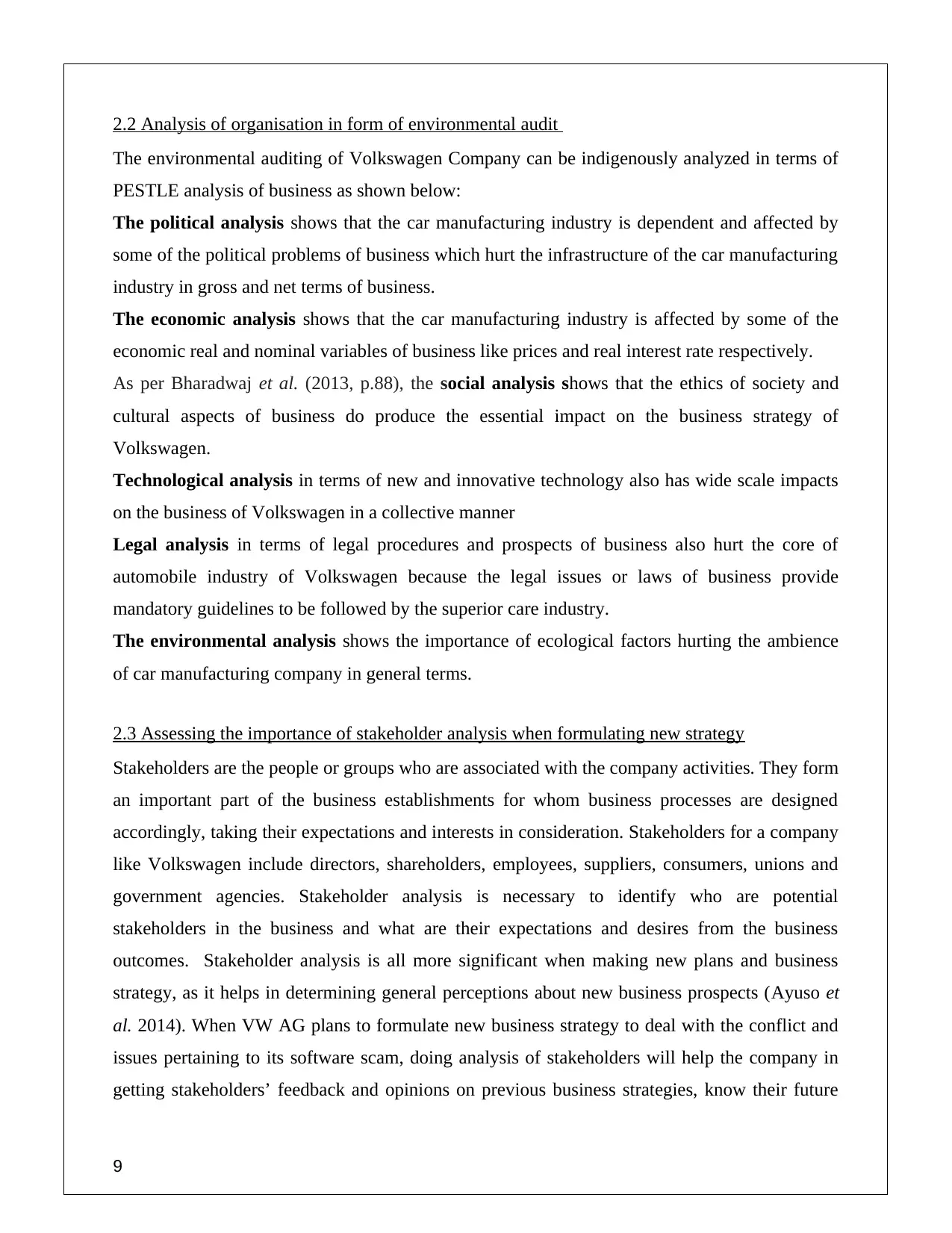
2.2 Analysis of organisation in form of environmental audit
The environmental auditing of Volkswagen Company can be indigenously analyzed in terms of
PESTLE analysis of business as shown below:
The political analysis shows that the car manufacturing industry is dependent and affected by
some of the political problems of business which hurt the infrastructure of the car manufacturing
industry in gross and net terms of business.
The economic analysis shows that the car manufacturing industry is affected by some of the
economic real and nominal variables of business like prices and real interest rate respectively.
As per Bharadwaj et al. (2013, p.88), the social analysis shows that the ethics of society and
cultural aspects of business do produce the essential impact on the business strategy of
Volkswagen.
Technological analysis in terms of new and innovative technology also has wide scale impacts
on the business of Volkswagen in a collective manner
Legal analysis in terms of legal procedures and prospects of business also hurt the core of
automobile industry of Volkswagen because the legal issues or laws of business provide
mandatory guidelines to be followed by the superior care industry.
The environmental analysis shows the importance of ecological factors hurting the ambience
of car manufacturing company in general terms.
2.3 Assessing the importance of stakeholder analysis when formulating new strategy
Stakeholders are the people or groups who are associated with the company activities. They form
an important part of the business establishments for whom business processes are designed
accordingly, taking their expectations and interests in consideration. Stakeholders for a company
like Volkswagen include directors, shareholders, employees, suppliers, consumers, unions and
government agencies. Stakeholder analysis is necessary to identify who are potential
stakeholders in the business and what are their expectations and desires from the business
outcomes. Stakeholder analysis is all more significant when making new plans and business
strategy, as it helps in determining general perceptions about new business prospects (Ayuso et
al. 2014). When VW AG plans to formulate new business strategy to deal with the conflict and
issues pertaining to its software scam, doing analysis of stakeholders will help the company in
getting stakeholders’ feedback and opinions on previous business strategies, know their future
9
The environmental auditing of Volkswagen Company can be indigenously analyzed in terms of
PESTLE analysis of business as shown below:
The political analysis shows that the car manufacturing industry is dependent and affected by
some of the political problems of business which hurt the infrastructure of the car manufacturing
industry in gross and net terms of business.
The economic analysis shows that the car manufacturing industry is affected by some of the
economic real and nominal variables of business like prices and real interest rate respectively.
As per Bharadwaj et al. (2013, p.88), the social analysis shows that the ethics of society and
cultural aspects of business do produce the essential impact on the business strategy of
Volkswagen.
Technological analysis in terms of new and innovative technology also has wide scale impacts
on the business of Volkswagen in a collective manner
Legal analysis in terms of legal procedures and prospects of business also hurt the core of
automobile industry of Volkswagen because the legal issues or laws of business provide
mandatory guidelines to be followed by the superior care industry.
The environmental analysis shows the importance of ecological factors hurting the ambience
of car manufacturing company in general terms.
2.3 Assessing the importance of stakeholder analysis when formulating new strategy
Stakeholders are the people or groups who are associated with the company activities. They form
an important part of the business establishments for whom business processes are designed
accordingly, taking their expectations and interests in consideration. Stakeholders for a company
like Volkswagen include directors, shareholders, employees, suppliers, consumers, unions and
government agencies. Stakeholder analysis is necessary to identify who are potential
stakeholders in the business and what are their expectations and desires from the business
outcomes. Stakeholder analysis is all more significant when making new plans and business
strategy, as it helps in determining general perceptions about new business prospects (Ayuso et
al. 2014). When VW AG plans to formulate new business strategy to deal with the conflict and
issues pertaining to its software scam, doing analysis of stakeholders will help the company in
getting stakeholders’ feedback and opinions on previous business strategies, know their future
9
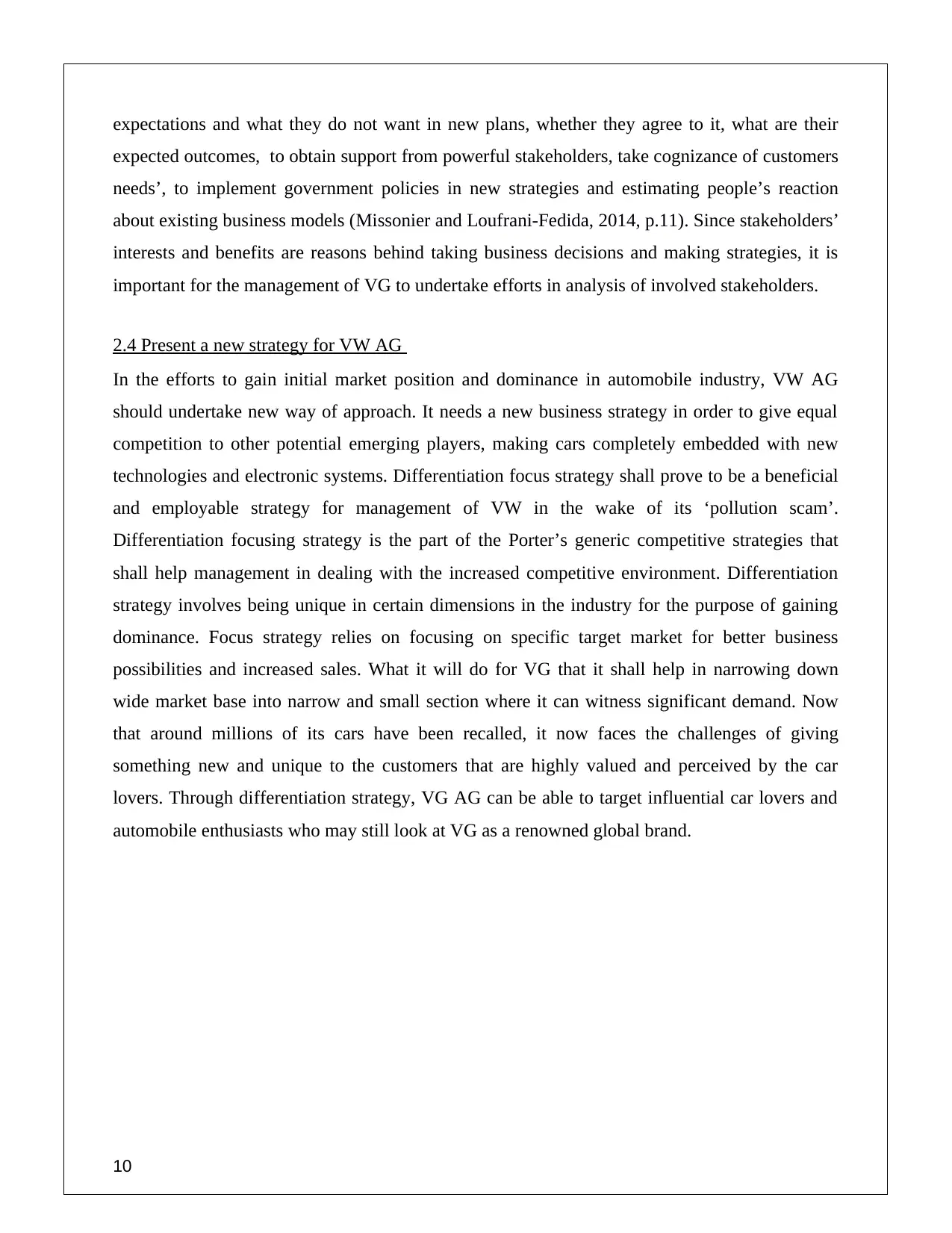
expectations and what they do not want in new plans, whether they agree to it, what are their
expected outcomes, to obtain support from powerful stakeholders, take cognizance of customers
needs’, to implement government policies in new strategies and estimating people’s reaction
about existing business models (Missonier and Loufrani-Fedida, 2014, p.11). Since stakeholders’
interests and benefits are reasons behind taking business decisions and making strategies, it is
important for the management of VG to undertake efforts in analysis of involved stakeholders.
2.4 Present a new strategy for VW AG
In the efforts to gain initial market position and dominance in automobile industry, VW AG
should undertake new way of approach. It needs a new business strategy in order to give equal
competition to other potential emerging players, making cars completely embedded with new
technologies and electronic systems. Differentiation focus strategy shall prove to be a beneficial
and employable strategy for management of VW in the wake of its ‘pollution scam’.
Differentiation focusing strategy is the part of the Porter’s generic competitive strategies that
shall help management in dealing with the increased competitive environment. Differentiation
strategy involves being unique in certain dimensions in the industry for the purpose of gaining
dominance. Focus strategy relies on focusing on specific target market for better business
possibilities and increased sales. What it will do for VG that it shall help in narrowing down
wide market base into narrow and small section where it can witness significant demand. Now
that around millions of its cars have been recalled, it now faces the challenges of giving
something new and unique to the customers that are highly valued and perceived by the car
lovers. Through differentiation strategy, VG AG can be able to target influential car lovers and
automobile enthusiasts who may still look at VG as a renowned global brand.
10
expected outcomes, to obtain support from powerful stakeholders, take cognizance of customers
needs’, to implement government policies in new strategies and estimating people’s reaction
about existing business models (Missonier and Loufrani-Fedida, 2014, p.11). Since stakeholders’
interests and benefits are reasons behind taking business decisions and making strategies, it is
important for the management of VG to undertake efforts in analysis of involved stakeholders.
2.4 Present a new strategy for VW AG
In the efforts to gain initial market position and dominance in automobile industry, VW AG
should undertake new way of approach. It needs a new business strategy in order to give equal
competition to other potential emerging players, making cars completely embedded with new
technologies and electronic systems. Differentiation focus strategy shall prove to be a beneficial
and employable strategy for management of VW in the wake of its ‘pollution scam’.
Differentiation focusing strategy is the part of the Porter’s generic competitive strategies that
shall help management in dealing with the increased competitive environment. Differentiation
strategy involves being unique in certain dimensions in the industry for the purpose of gaining
dominance. Focus strategy relies on focusing on specific target market for better business
possibilities and increased sales. What it will do for VG that it shall help in narrowing down
wide market base into narrow and small section where it can witness significant demand. Now
that around millions of its cars have been recalled, it now faces the challenges of giving
something new and unique to the customers that are highly valued and perceived by the car
lovers. Through differentiation strategy, VG AG can be able to target influential car lovers and
automobile enthusiasts who may still look at VG as a renowned global brand.
10
Secure Best Marks with AI Grader
Need help grading? Try our AI Grader for instant feedback on your assignments.
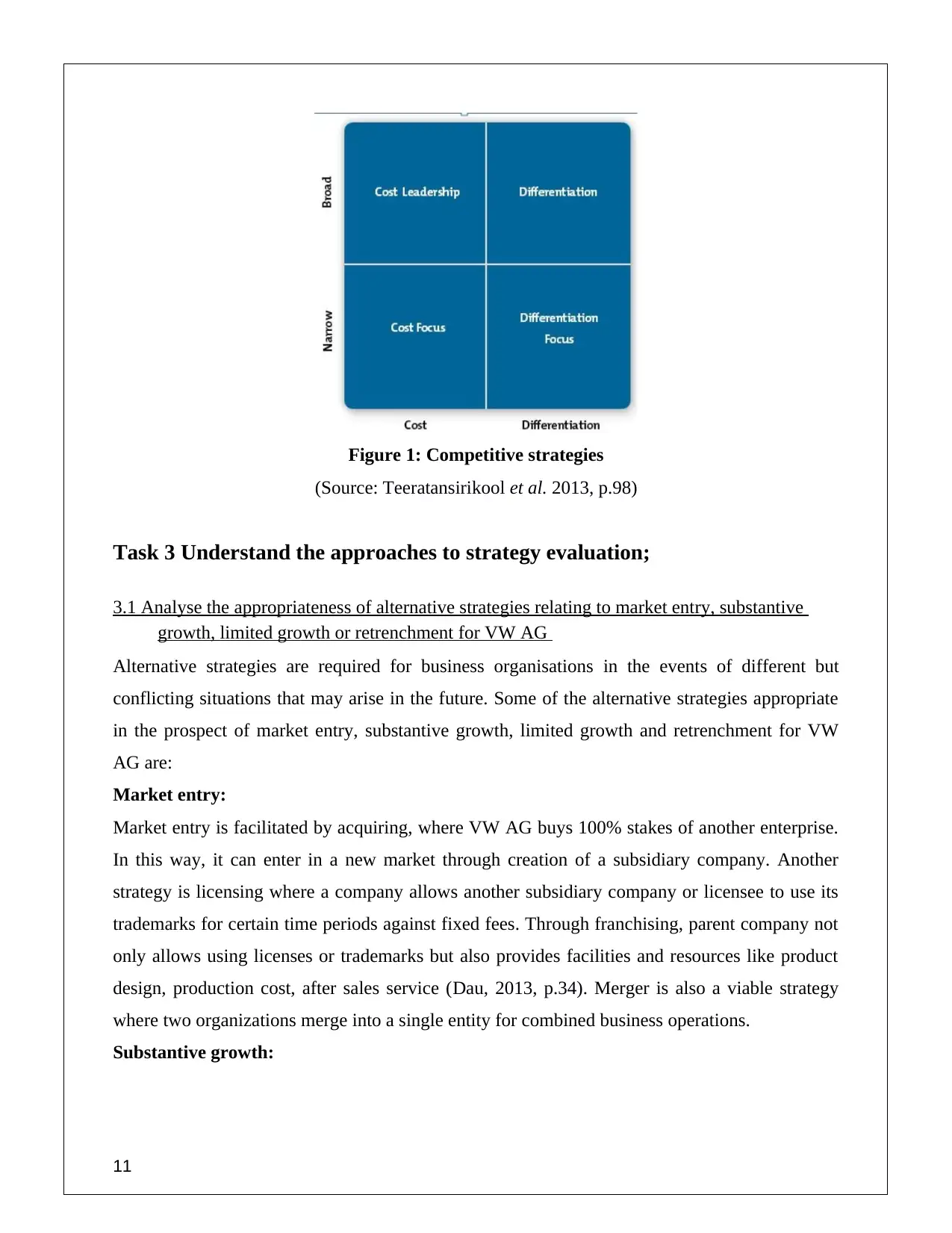
Figure 1: Competitive strategies
(Source: Teeratansirikool et al. 2013, p.98)
Task 3 Understand the approaches to strategy evaluation;
3.1 Analyse the appropriateness of alternative strategies relating to market entry, substantive
growth, limited growth or retrenchment for VW AG
Alternative strategies are required for business organisations in the events of different but
conflicting situations that may arise in the future. Some of the alternative strategies appropriate
in the prospect of market entry, substantive growth, limited growth and retrenchment for VW
AG are:
Market entry:
Market entry is facilitated by acquiring, where VW AG buys 100% stakes of another enterprise.
In this way, it can enter in a new market through creation of a subsidiary company. Another
strategy is licensing where a company allows another subsidiary company or licensee to use its
trademarks for certain time periods against fixed fees. Through franchising, parent company not
only allows using licenses or trademarks but also provides facilities and resources like product
design, production cost, after sales service (Dau, 2013, p.34). Merger is also a viable strategy
where two organizations merge into a single entity for combined business operations.
Substantive growth:
11
(Source: Teeratansirikool et al. 2013, p.98)
Task 3 Understand the approaches to strategy evaluation;
3.1 Analyse the appropriateness of alternative strategies relating to market entry, substantive
growth, limited growth or retrenchment for VW AG
Alternative strategies are required for business organisations in the events of different but
conflicting situations that may arise in the future. Some of the alternative strategies appropriate
in the prospect of market entry, substantive growth, limited growth and retrenchment for VW
AG are:
Market entry:
Market entry is facilitated by acquiring, where VW AG buys 100% stakes of another enterprise.
In this way, it can enter in a new market through creation of a subsidiary company. Another
strategy is licensing where a company allows another subsidiary company or licensee to use its
trademarks for certain time periods against fixed fees. Through franchising, parent company not
only allows using licenses or trademarks but also provides facilities and resources like product
design, production cost, after sales service (Dau, 2013, p.34). Merger is also a viable strategy
where two organizations merge into a single entity for combined business operations.
Substantive growth:
11
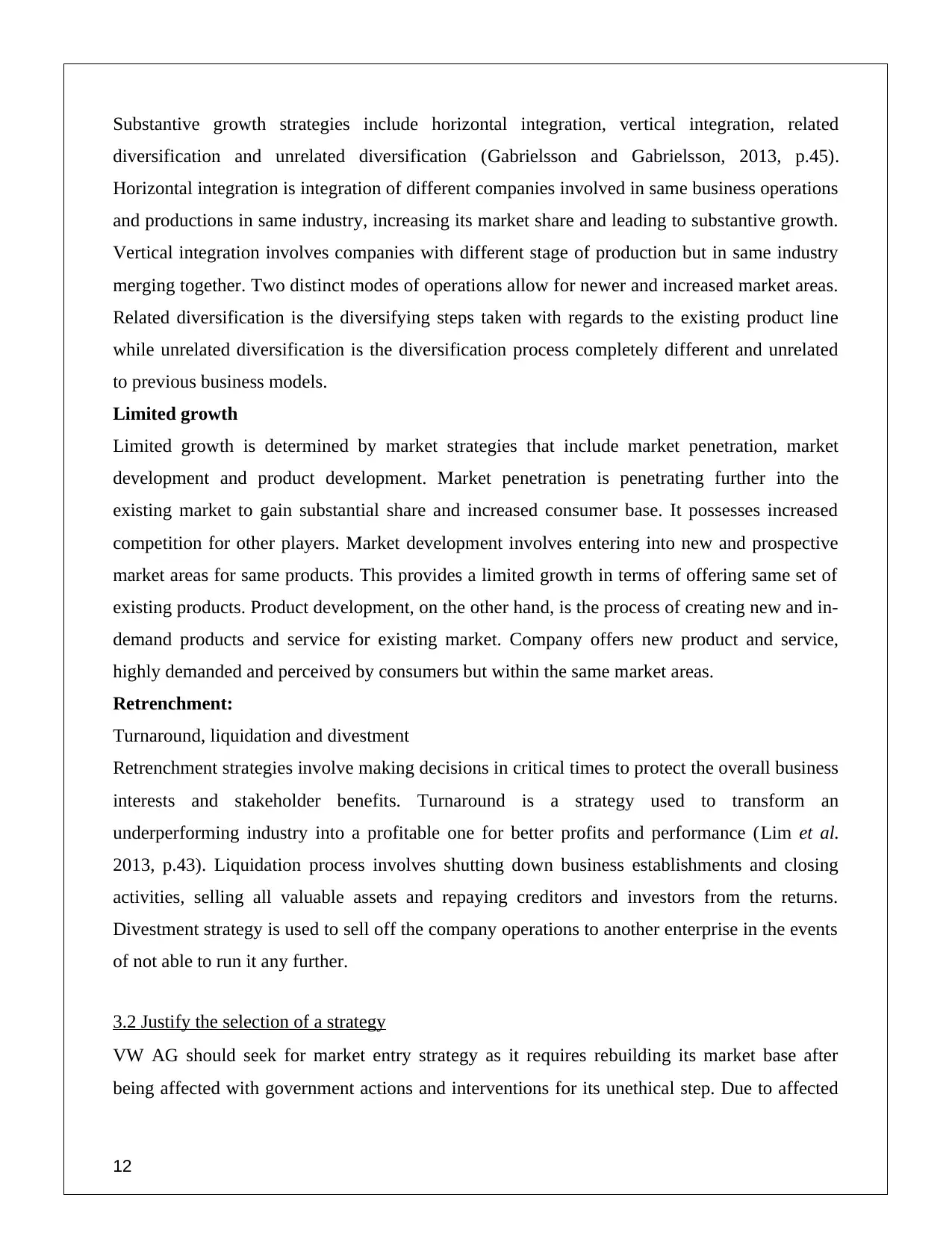
Substantive growth strategies include horizontal integration, vertical integration, related
diversification and unrelated diversification (Gabrielsson and Gabrielsson, 2013, p.45).
Horizontal integration is integration of different companies involved in same business operations
and productions in same industry, increasing its market share and leading to substantive growth.
Vertical integration involves companies with different stage of production but in same industry
merging together. Two distinct modes of operations allow for newer and increased market areas.
Related diversification is the diversifying steps taken with regards to the existing product line
while unrelated diversification is the diversification process completely different and unrelated
to previous business models.
Limited growth
Limited growth is determined by market strategies that include market penetration, market
development and product development. Market penetration is penetrating further into the
existing market to gain substantial share and increased consumer base. It possesses increased
competition for other players. Market development involves entering into new and prospective
market areas for same products. This provides a limited growth in terms of offering same set of
existing products. Product development, on the other hand, is the process of creating new and in-
demand products and service for existing market. Company offers new product and service,
highly demanded and perceived by consumers but within the same market areas.
Retrenchment:
Turnaround, liquidation and divestment
Retrenchment strategies involve making decisions in critical times to protect the overall business
interests and stakeholder benefits. Turnaround is a strategy used to transform an
underperforming industry into a profitable one for better profits and performance (Lim et al.
2013, p.43). Liquidation process involves shutting down business establishments and closing
activities, selling all valuable assets and repaying creditors and investors from the returns.
Divestment strategy is used to sell off the company operations to another enterprise in the events
of not able to run it any further.
3.2 Justify the selection of a strategy
VW AG should seek for market entry strategy as it requires rebuilding its market base after
being affected with government actions and interventions for its unethical step. Due to affected
12
diversification and unrelated diversification (Gabrielsson and Gabrielsson, 2013, p.45).
Horizontal integration is integration of different companies involved in same business operations
and productions in same industry, increasing its market share and leading to substantive growth.
Vertical integration involves companies with different stage of production but in same industry
merging together. Two distinct modes of operations allow for newer and increased market areas.
Related diversification is the diversifying steps taken with regards to the existing product line
while unrelated diversification is the diversification process completely different and unrelated
to previous business models.
Limited growth
Limited growth is determined by market strategies that include market penetration, market
development and product development. Market penetration is penetrating further into the
existing market to gain substantial share and increased consumer base. It possesses increased
competition for other players. Market development involves entering into new and prospective
market areas for same products. This provides a limited growth in terms of offering same set of
existing products. Product development, on the other hand, is the process of creating new and in-
demand products and service for existing market. Company offers new product and service,
highly demanded and perceived by consumers but within the same market areas.
Retrenchment:
Turnaround, liquidation and divestment
Retrenchment strategies involve making decisions in critical times to protect the overall business
interests and stakeholder benefits. Turnaround is a strategy used to transform an
underperforming industry into a profitable one for better profits and performance (Lim et al.
2013, p.43). Liquidation process involves shutting down business establishments and closing
activities, selling all valuable assets and repaying creditors and investors from the returns.
Divestment strategy is used to sell off the company operations to another enterprise in the events
of not able to run it any further.
3.2 Justify the selection of a strategy
VW AG should seek for market entry strategy as it requires rebuilding its market base after
being affected with government actions and interventions for its unethical step. Due to affected
12
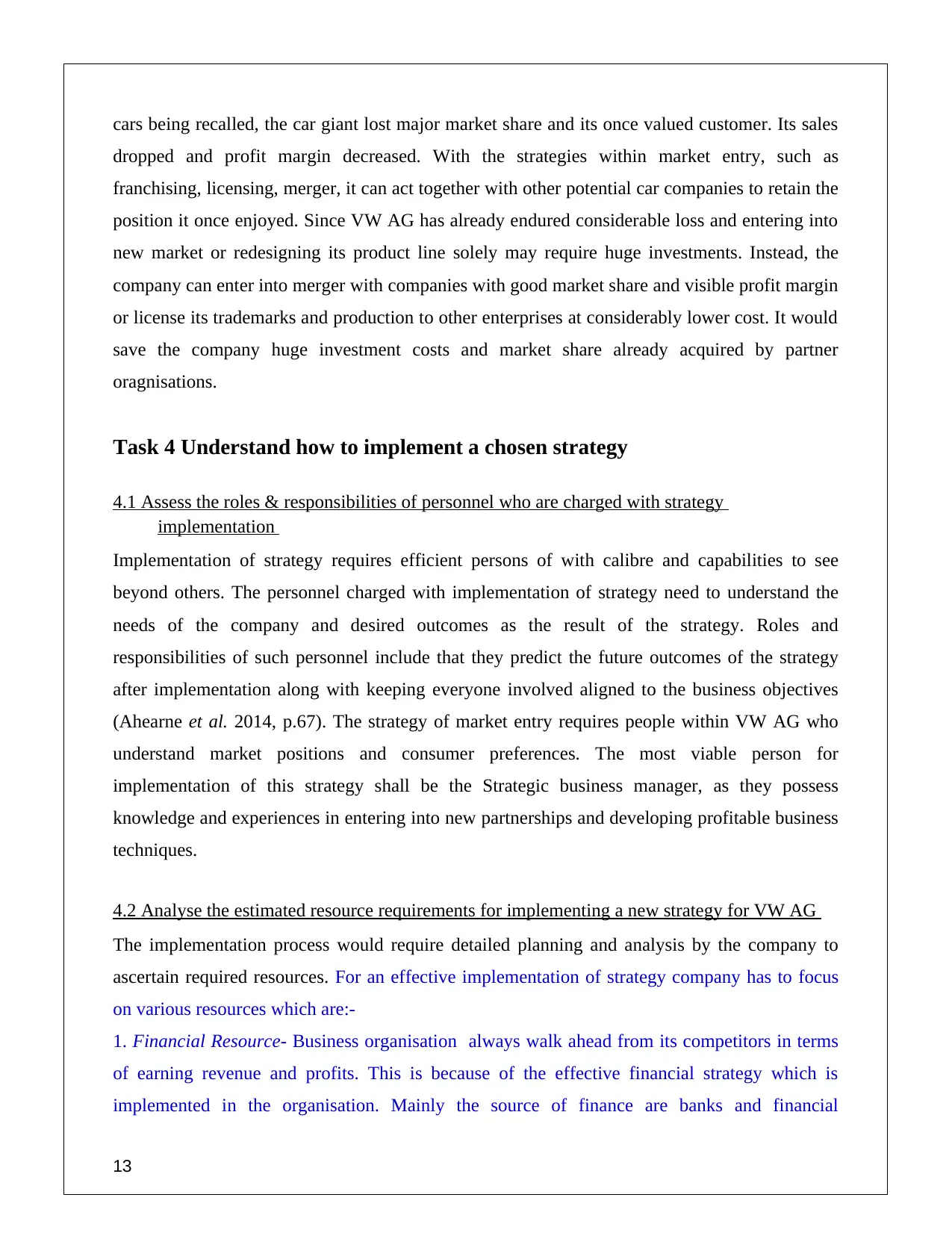
cars being recalled, the car giant lost major market share and its once valued customer. Its sales
dropped and profit margin decreased. With the strategies within market entry, such as
franchising, licensing, merger, it can act together with other potential car companies to retain the
position it once enjoyed. Since VW AG has already endured considerable loss and entering into
new market or redesigning its product line solely may require huge investments. Instead, the
company can enter into merger with companies with good market share and visible profit margin
or license its trademarks and production to other enterprises at considerably lower cost. It would
save the company huge investment costs and market share already acquired by partner
oragnisations.
Task 4 Understand how to implement a chosen strategy
4.1 Assess the roles & responsibilities of personnel who are charged with strategy
implementation
Implementation of strategy requires efficient persons of with calibre and capabilities to see
beyond others. The personnel charged with implementation of strategy need to understand the
needs of the company and desired outcomes as the result of the strategy. Roles and
responsibilities of such personnel include that they predict the future outcomes of the strategy
after implementation along with keeping everyone involved aligned to the business objectives
(Ahearne et al. 2014, p.67). The strategy of market entry requires people within VW AG who
understand market positions and consumer preferences. The most viable person for
implementation of this strategy shall be the Strategic business manager, as they possess
knowledge and experiences in entering into new partnerships and developing profitable business
techniques.
4.2 Analyse the estimated resource requirements for implementing a new strategy for VW AG
The implementation process would require detailed planning and analysis by the company to
ascertain required resources. For an effective implementation of strategy company has to focus
on various resources which are:-
1. Financial Resource- Business organisation always walk ahead from its competitors in terms
of earning revenue and profits. This is because of the effective financial strategy which is
implemented in the organisation. Mainly the source of finance are banks and financial
13
dropped and profit margin decreased. With the strategies within market entry, such as
franchising, licensing, merger, it can act together with other potential car companies to retain the
position it once enjoyed. Since VW AG has already endured considerable loss and entering into
new market or redesigning its product line solely may require huge investments. Instead, the
company can enter into merger with companies with good market share and visible profit margin
or license its trademarks and production to other enterprises at considerably lower cost. It would
save the company huge investment costs and market share already acquired by partner
oragnisations.
Task 4 Understand how to implement a chosen strategy
4.1 Assess the roles & responsibilities of personnel who are charged with strategy
implementation
Implementation of strategy requires efficient persons of with calibre and capabilities to see
beyond others. The personnel charged with implementation of strategy need to understand the
needs of the company and desired outcomes as the result of the strategy. Roles and
responsibilities of such personnel include that they predict the future outcomes of the strategy
after implementation along with keeping everyone involved aligned to the business objectives
(Ahearne et al. 2014, p.67). The strategy of market entry requires people within VW AG who
understand market positions and consumer preferences. The most viable person for
implementation of this strategy shall be the Strategic business manager, as they possess
knowledge and experiences in entering into new partnerships and developing profitable business
techniques.
4.2 Analyse the estimated resource requirements for implementing a new strategy for VW AG
The implementation process would require detailed planning and analysis by the company to
ascertain required resources. For an effective implementation of strategy company has to focus
on various resources which are:-
1. Financial Resource- Business organisation always walk ahead from its competitors in terms
of earning revenue and profits. This is because of the effective financial strategy which is
implemented in the organisation. Mainly the source of finance are banks and financial
13
Paraphrase This Document
Need a fresh take? Get an instant paraphrase of this document with our AI Paraphraser
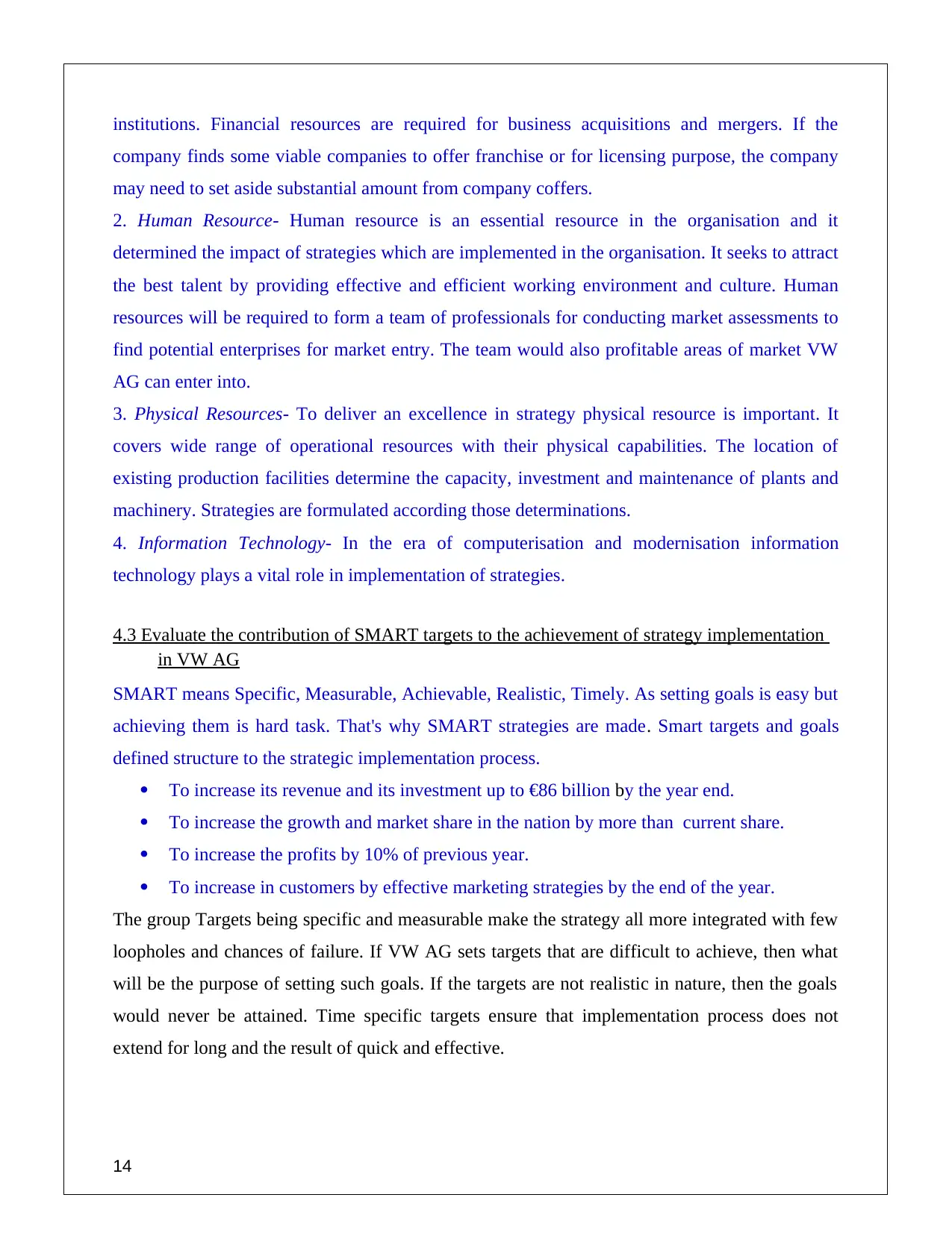
institutions. Financial resources are required for business acquisitions and mergers. If the
company finds some viable companies to offer franchise or for licensing purpose, the company
may need to set aside substantial amount from company coffers.
2. Human Resource- Human resource is an essential resource in the organisation and it
determined the impact of strategies which are implemented in the organisation. It seeks to attract
the best talent by providing effective and efficient working environment and culture. Human
resources will be required to form a team of professionals for conducting market assessments to
find potential enterprises for market entry. The team would also profitable areas of market VW
AG can enter into.
3. Physical Resources- To deliver an excellence in strategy physical resource is important. It
covers wide range of operational resources with their physical capabilities. The location of
existing production facilities determine the capacity, investment and maintenance of plants and
machinery. Strategies are formulated according those determinations.
4. Information Technology- In the era of computerisation and modernisation information
technology plays a vital role in implementation of strategies.
4.3 Evaluate the contribution of SMART targets to the achievement of strategy implementation
in VW AG
SMART means Specific, Measurable, Achievable, Realistic, Timely. As setting goals is easy but
achieving them is hard task. That's why SMART strategies are made. Smart targets and goals
defined structure to the strategic implementation process.
To increase its revenue and its investment up to €86 billion by the year end.
To increase the growth and market share in the nation by more than current share.
To increase the profits by 10% of previous year.
To increase in customers by effective marketing strategies by the end of the year.
The group Targets being specific and measurable make the strategy all more integrated with few
loopholes and chances of failure. If VW AG sets targets that are difficult to achieve, then what
will be the purpose of setting such goals. If the targets are not realistic in nature, then the goals
would never be attained. Time specific targets ensure that implementation process does not
extend for long and the result of quick and effective.
14
company finds some viable companies to offer franchise or for licensing purpose, the company
may need to set aside substantial amount from company coffers.
2. Human Resource- Human resource is an essential resource in the organisation and it
determined the impact of strategies which are implemented in the organisation. It seeks to attract
the best talent by providing effective and efficient working environment and culture. Human
resources will be required to form a team of professionals for conducting market assessments to
find potential enterprises for market entry. The team would also profitable areas of market VW
AG can enter into.
3. Physical Resources- To deliver an excellence in strategy physical resource is important. It
covers wide range of operational resources with their physical capabilities. The location of
existing production facilities determine the capacity, investment and maintenance of plants and
machinery. Strategies are formulated according those determinations.
4. Information Technology- In the era of computerisation and modernisation information
technology plays a vital role in implementation of strategies.
4.3 Evaluate the contribution of SMART targets to the achievement of strategy implementation
in VW AG
SMART means Specific, Measurable, Achievable, Realistic, Timely. As setting goals is easy but
achieving them is hard task. That's why SMART strategies are made. Smart targets and goals
defined structure to the strategic implementation process.
To increase its revenue and its investment up to €86 billion by the year end.
To increase the growth and market share in the nation by more than current share.
To increase the profits by 10% of previous year.
To increase in customers by effective marketing strategies by the end of the year.
The group Targets being specific and measurable make the strategy all more integrated with few
loopholes and chances of failure. If VW AG sets targets that are difficult to achieve, then what
will be the purpose of setting such goals. If the targets are not realistic in nature, then the goals
would never be attained. Time specific targets ensure that implementation process does not
extend for long and the result of quick and effective.
14
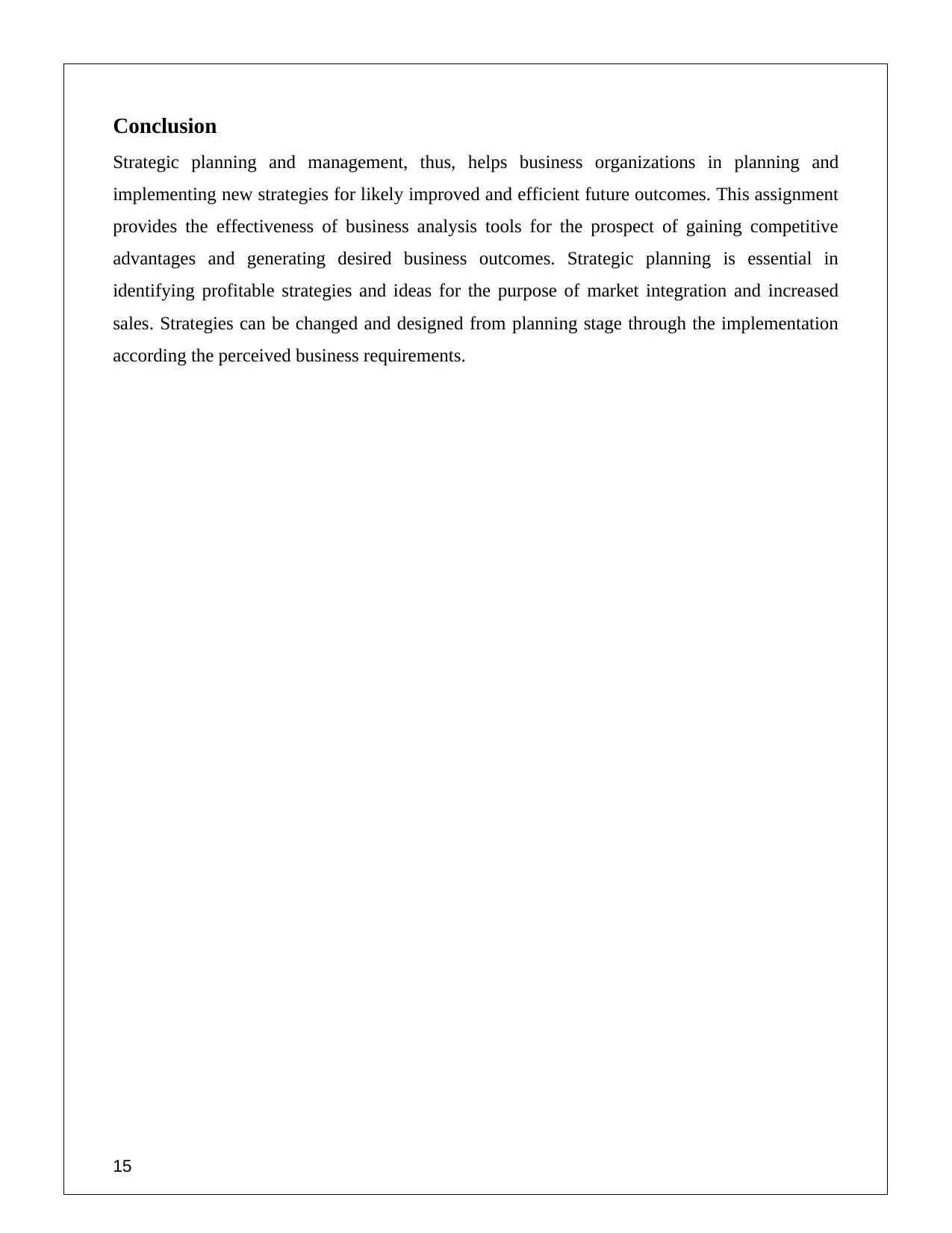
Conclusion
Strategic planning and management, thus, helps business organizations in planning and
implementing new strategies for likely improved and efficient future outcomes. This assignment
provides the effectiveness of business analysis tools for the prospect of gaining competitive
advantages and generating desired business outcomes. Strategic planning is essential in
identifying profitable strategies and ideas for the purpose of market integration and increased
sales. Strategies can be changed and designed from planning stage through the implementation
according the perceived business requirements.
15
Strategic planning and management, thus, helps business organizations in planning and
implementing new strategies for likely improved and efficient future outcomes. This assignment
provides the effectiveness of business analysis tools for the prospect of gaining competitive
advantages and generating desired business outcomes. Strategic planning is essential in
identifying profitable strategies and ideas for the purpose of market integration and increased
sales. Strategies can be changed and designed from planning stage through the implementation
according the perceived business requirements.
15
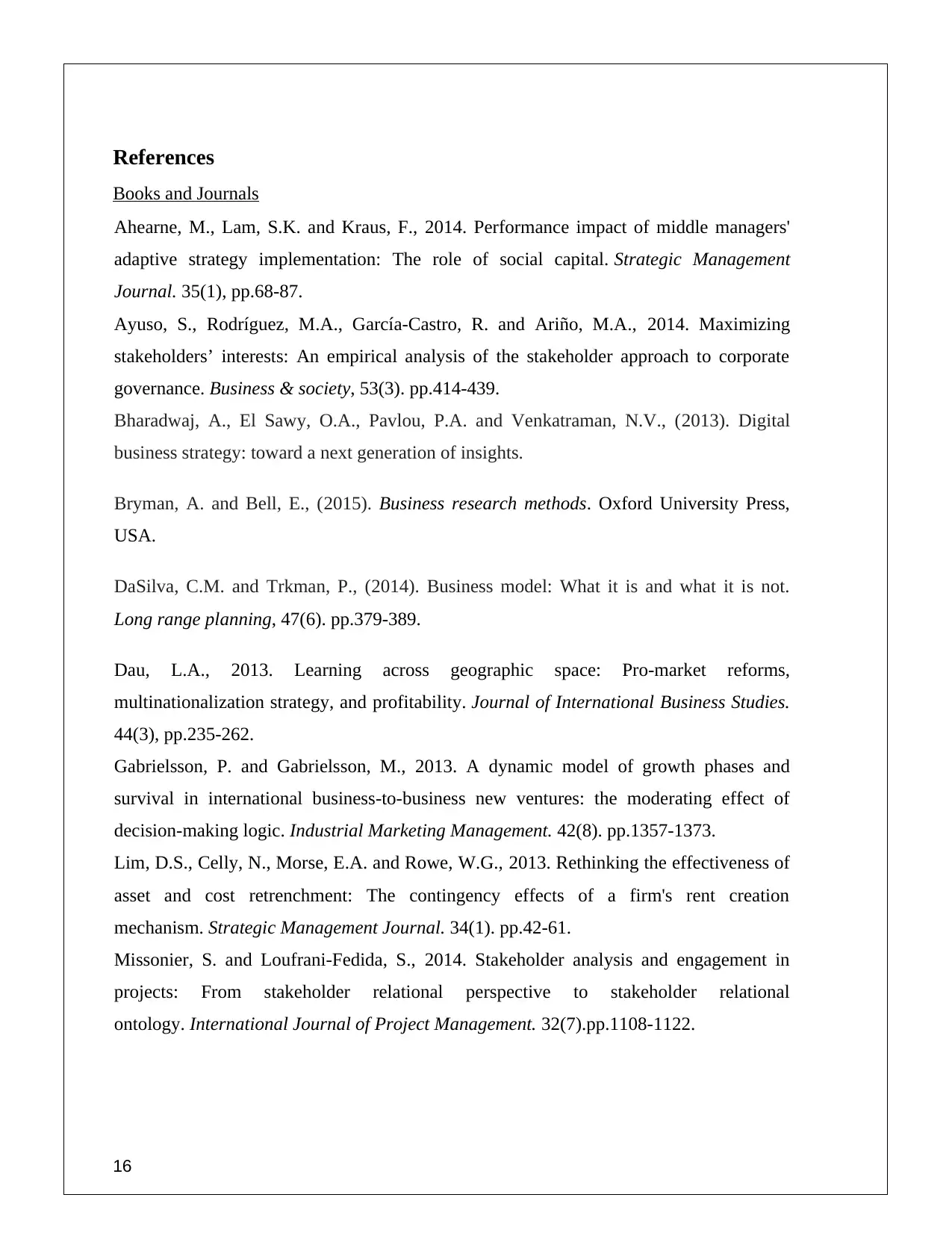
References
Books and Journals
Ahearne, M., Lam, S.K. and Kraus, F., 2014. Performance impact of middle managers'
adaptive strategy implementation: The role of social capital. Strategic Management
Journal. 35(1), pp.68-87.
Ayuso, S., Rodríguez, M.A., García-Castro, R. and Ariño, M.A., 2014. Maximizing
stakeholders’ interests: An empirical analysis of the stakeholder approach to corporate
governance. Business & society, 53(3). pp.414-439.
Bharadwaj, A., El Sawy, O.A., Pavlou, P.A. and Venkatraman, N.V., (2013). Digital
business strategy: toward a next generation of insights.
Bryman, A. and Bell, E., (2015). Business research methods. Oxford University Press,
USA.
DaSilva, C.M. and Trkman, P., (2014). Business model: What it is and what it is not.
Long range planning, 47(6). pp.379-389.
Dau, L.A., 2013. Learning across geographic space: Pro-market reforms,
multinationalization strategy, and profitability. Journal of International Business Studies.
44(3), pp.235-262.
Gabrielsson, P. and Gabrielsson, M., 2013. A dynamic model of growth phases and
survival in international business-to-business new ventures: the moderating effect of
decision-making logic. Industrial Marketing Management. 42(8). pp.1357-1373.
Lim, D.S., Celly, N., Morse, E.A. and Rowe, W.G., 2013. Rethinking the effectiveness of
asset and cost retrenchment: The contingency effects of a firm's rent creation
mechanism. Strategic Management Journal. 34(1). pp.42-61.
Missonier, S. and Loufrani-Fedida, S., 2014. Stakeholder analysis and engagement in
projects: From stakeholder relational perspective to stakeholder relational
ontology. International Journal of Project Management. 32(7).pp.1108-1122.
16
Books and Journals
Ahearne, M., Lam, S.K. and Kraus, F., 2014. Performance impact of middle managers'
adaptive strategy implementation: The role of social capital. Strategic Management
Journal. 35(1), pp.68-87.
Ayuso, S., Rodríguez, M.A., García-Castro, R. and Ariño, M.A., 2014. Maximizing
stakeholders’ interests: An empirical analysis of the stakeholder approach to corporate
governance. Business & society, 53(3). pp.414-439.
Bharadwaj, A., El Sawy, O.A., Pavlou, P.A. and Venkatraman, N.V., (2013). Digital
business strategy: toward a next generation of insights.
Bryman, A. and Bell, E., (2015). Business research methods. Oxford University Press,
USA.
DaSilva, C.M. and Trkman, P., (2014). Business model: What it is and what it is not.
Long range planning, 47(6). pp.379-389.
Dau, L.A., 2013. Learning across geographic space: Pro-market reforms,
multinationalization strategy, and profitability. Journal of International Business Studies.
44(3), pp.235-262.
Gabrielsson, P. and Gabrielsson, M., 2013. A dynamic model of growth phases and
survival in international business-to-business new ventures: the moderating effect of
decision-making logic. Industrial Marketing Management. 42(8). pp.1357-1373.
Lim, D.S., Celly, N., Morse, E.A. and Rowe, W.G., 2013. Rethinking the effectiveness of
asset and cost retrenchment: The contingency effects of a firm's rent creation
mechanism. Strategic Management Journal. 34(1). pp.42-61.
Missonier, S. and Loufrani-Fedida, S., 2014. Stakeholder analysis and engagement in
projects: From stakeholder relational perspective to stakeholder relational
ontology. International Journal of Project Management. 32(7).pp.1108-1122.
16
Secure Best Marks with AI Grader
Need help grading? Try our AI Grader for instant feedback on your assignments.
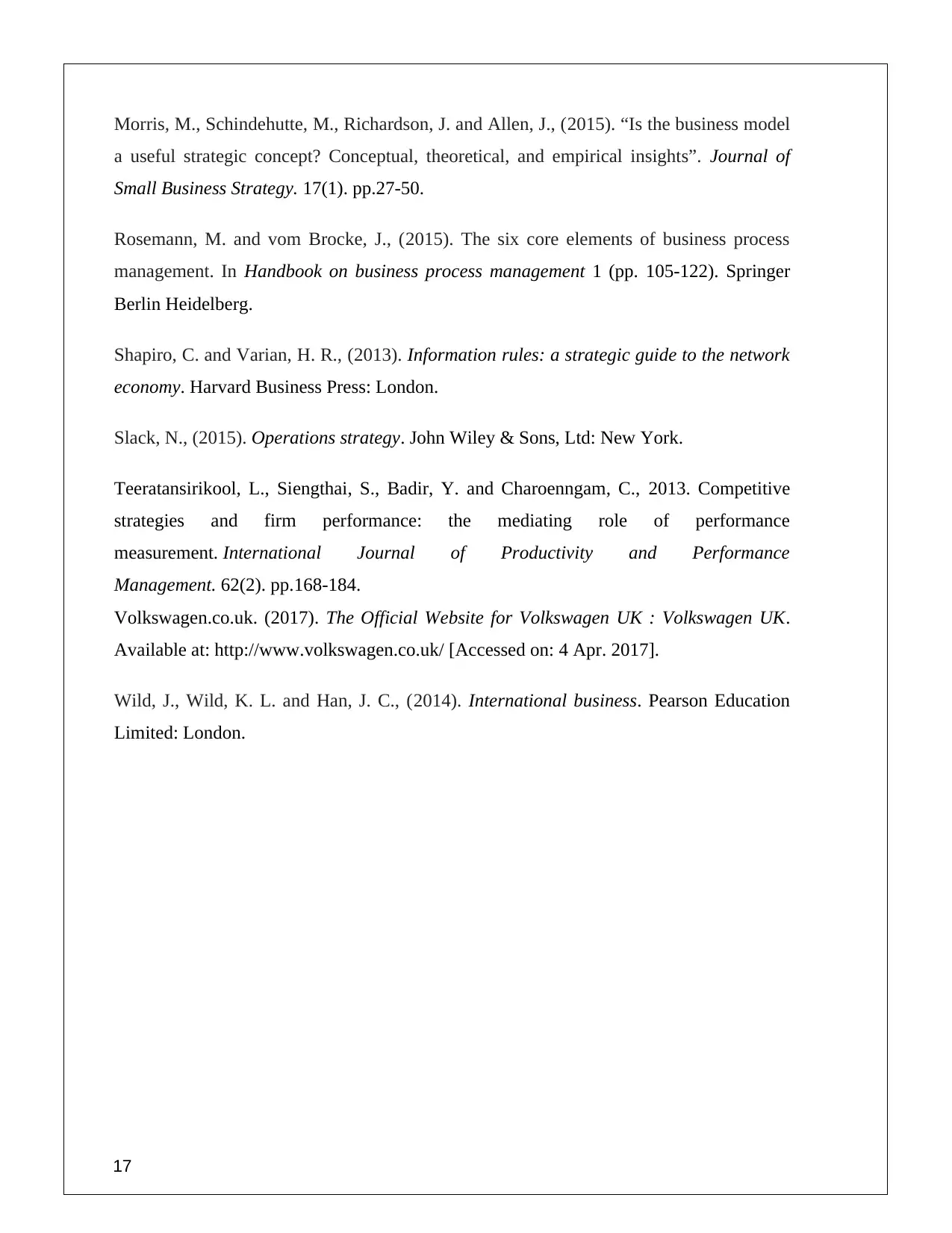
Morris, M., Schindehutte, M., Richardson, J. and Allen, J., (2015). “Is the business model
a useful strategic concept? Conceptual, theoretical, and empirical insights”. Journal of
Small Business Strategy. 17(1). pp.27-50.
Rosemann, M. and vom Brocke, J., (2015). The six core elements of business process
management. In Handbook on business process management 1 (pp. 105-122). Springer
Berlin Heidelberg.
Shapiro, C. and Varian, H. R., (2013). Information rules: a strategic guide to the network
economy. Harvard Business Press: London.
Slack, N., (2015). Operations strategy. John Wiley & Sons, Ltd: New York.
Teeratansirikool, L., Siengthai, S., Badir, Y. and Charoenngam, C., 2013. Competitive
strategies and firm performance: the mediating role of performance
measurement. International Journal of Productivity and Performance
Management. 62(2). pp.168-184.
Volkswagen.co.uk. (2017). The Official Website for Volkswagen UK : Volkswagen UK.
Available at: http://www.volkswagen.co.uk/ [Accessed on: 4 Apr. 2017].
Wild, J., Wild, K. L. and Han, J. C., (2014). International business. Pearson Education
Limited: London.
17
a useful strategic concept? Conceptual, theoretical, and empirical insights”. Journal of
Small Business Strategy. 17(1). pp.27-50.
Rosemann, M. and vom Brocke, J., (2015). The six core elements of business process
management. In Handbook on business process management 1 (pp. 105-122). Springer
Berlin Heidelberg.
Shapiro, C. and Varian, H. R., (2013). Information rules: a strategic guide to the network
economy. Harvard Business Press: London.
Slack, N., (2015). Operations strategy. John Wiley & Sons, Ltd: New York.
Teeratansirikool, L., Siengthai, S., Badir, Y. and Charoenngam, C., 2013. Competitive
strategies and firm performance: the mediating role of performance
measurement. International Journal of Productivity and Performance
Management. 62(2). pp.168-184.
Volkswagen.co.uk. (2017). The Official Website for Volkswagen UK : Volkswagen UK.
Available at: http://www.volkswagen.co.uk/ [Accessed on: 4 Apr. 2017].
Wild, J., Wild, K. L. and Han, J. C., (2014). International business. Pearson Education
Limited: London.
17
1 out of 17
Related Documents
Your All-in-One AI-Powered Toolkit for Academic Success.
+13062052269
info@desklib.com
Available 24*7 on WhatsApp / Email
![[object Object]](/_next/static/media/star-bottom.7253800d.svg)
Unlock your academic potential
© 2024 | Zucol Services PVT LTD | All rights reserved.





